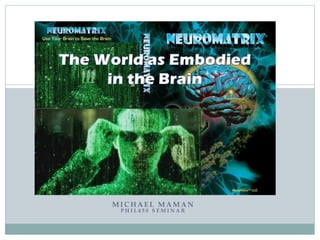
Neuromatrix-7
- 1. M I C H A E L M A M A N P H I L 4 5 0 S E M I N A R Neuromatrix: The World as Embodied in the Mind
- 2. What’s “real” and what is “fantasy”? University of Florence study Mazzoni and Loftus. “When Dreams Become Reality.” 1996. “Our interest is in whether dream content can be remembered as something that occurred during the waking state…If people sometimes confuse products of their imagination with actual experiences, they might also be expected to occasionally confuse dream material with reality” (442-43). After a single subtle suggestion, participants falsely recognized items from their dreams and thought that these items had been presented in a list that they learned during the waking state. Implications for the study’s findings?
- 3. Confounding Confabulation: Window into the Neuromatrix •Drawing on empirical data, Armin Schneider and William Hirstein illustrate the puzzling nature of confabulation, and how it can help us better understand the neural processes involved in discerning fiction from reality • In the example of Clinical vs. nonclinical cases of confabulation (e.g. Korsakoff’s syndrome, Capgra’s syndrome) ○Brain lesions
- 4. Confounding Confabulation: Window into the Neuromatrix (Part II) Connection between Orbitofrontal cortex (OFC) & mediodorsal nucleus Derailment of processes to ascertain beliefs ‘checking mechanisms’ monitoring knowledge domains damaged (Hirstein 179) • Non clinical cases: Self-deception ○ Are “healthy”individuals involved in similar, but less extreme forms of delusional thinking? ▪ ”…These phenomena (confabulations) in general are mirrored, if to a much more minor degree, in the retrieval protocols of normal subjects…”(Birgess and Shallice. “Confabulation and the Control of Recollection.” 1996.) • False memories (e.g. witness testimony)
- 5. “Making up the Mind” – Chris Frith “The distinction between the mental and the physical is…an illusion created by the brain” (Frith 17). • “Seeing through the Brain’s Illusions” ○ Consider brain injured patients and examine how our knowledge can be extended using “clues from a damaged brain.” • Human perception of the world not as direct as subjectively experienced • Complex, cognitive processes on unconscious level → Brain makes numerous unconscious inferences about the world, but even for “healthy” individuals the processes can be faulty
- 6. “Making up the Mind” (Part II) Examples: Hallucinations: Schizophrenia vs Visual illusions in healthy individuals In both cases, resulting mental representations are not always accurate depictions of reality. Imagining an action stimulates the same brain regions that function when the action is actually undertaken. Patients with phantom limb syndrome Experience sensations and visions that seem convincingly real. “Perception [cannot be] of the world, but of my brain’s model of the world” (Frith 132).
- 7. Is there a “Red Pill” to experience “Ultimate Reality”? • Ultimately, cognitive systems are not self- revealing. Experiences in our wakeful state are lived out in our minds, just as our dreams are. • Can we examine the unfiltered “real” objective external world? ○ How can we perceive the world as it “truly is”, if the brain has already decided what we are going to perceive? • All “this complex activity is hidden from us. So there is no need to be embarrassed. Just go back to the party and have fun.” (Frith p. 193).